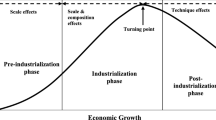Abstract
The relationship between democracy and environment is subject to controversy. Some scientists find that democracy has a positive impact in reducing environmental disruption. Other scholars claim that democracy tends to accelerate environmental degradation. By using deforestation rates as a proxy for environmental disruption, we suggest that both sides might be right. Our quantitative analysis has three important outcomes. First, there is evidence of an inverted U-shaped relationship between deforestation and democracy. Second, countries in democratic transition experience the highest deforestation rates, compared to non-democracies and mature democracies. Third, in explaining deforestation rates democracy has larger explanatory power than income. This last result implies that in reducing deforestation rates the emphasis should not only be on economic development but even more on democratization.
Similar content being viewed by others
References
Acemoglu D, Johnson S, Robinson JA, Yared P (2008) Income and democracy. Am Econ Rev 98(3): 808–842
Andersen MS (2002) Ecological modernization or subversion? The effect of europeanization on eastern Europe. Am Behav Sci 45(9): 1394–1416
Barrett S, Graddy K (2000) Freedom, growth, and the environment. Environ Dev Econ 5(4): 433–456
Bhattarai M, Hammig M (2001) Institutions and the Environmental Kuznets Curve for deforestation: a cross-country analysis for Latin America, Africa, and Asia. World Dev 29(6): 995–1010
Cropper M, Griffiths C (1994) The interaction of population growth and environmental quality. Am Econ Rev 84(2): 250–254
Dahl RA (1998) On democracy. Yale University Press, New Haven
Didia DO (1997) Democracy, political instability and tropical deforestation. Glob Environ Chang 7(1): 63–76
Doucouliagos H, Ulubaşoğlu MA (2008) Democracy and economic growth: a meta-analysis. Am J Pol Sci 52(1): 61–83
Elster, J (eds) (1998) Deliberative democracy. Cambridge University Press, Cambridge
Farzin YH, Bond CA (2006) Democracy and environmental quality. J Dev Econ 81(1): 213–235
Food and Agricultural Organization (2001) State of the world’s forests. Food and Agricultural Organization, Rome. http://www.fao.org/docrep/003/Y0900E/y0900e14.htm. Cited 13 October 2005
Freedom House (2000) Annual surveys of freedom country ratings 1972–1973 to 1999–2000. Freedom House, New York. http://www.freedomhouse.org/ratings/index.htm. Cited 15 October 2005
Freedom House (1999) Democracy’s century: a survey of global political change in the 20th century. Freedom House, New York. http://www.freedomhouse.org/reports/century.html. Cited 15 October 2005
Fredriksson PG, Svensson J (2003) Political instability, corruption and policy formation: the case of environmental policy. J Public Econ 87(7–8): 1383–1405
Garson GD (2006) Statnotes: an introduction to multivariate analysis. Statistics Solutions, Inc, Clearwater. http://www.statisticssolutions.com. Cited 15 October 2008
Huntington SP (1991) The third wave: democratization in the late twentieth century. University of Oklahoma Press, Norman
Li Q, Reuveny R (2006) Democracy and environmental degradation. Int Stud Quart 50: 935–956
Marshall MG, Jaggers K (2002) Polity IV project: political regime characteristics and transitions, 1800–2002. University of Maryland. http://www.cidcm.umd.edu/inscr/polity/index.htm. Cited 20 September 2005
Martinez KE, Crenshaw EM, Jenkins JC (2002) Deforestation and the Environmental Kuznets Curve: a cross-national investigation of intervening mechanisms. Soc Sci Quart 83(1): 226–243
Meyer AL, van Kooten GC, Wang S (2003) Institutional, social and economic roots of deforestation: further evidence of an environmental Kuznets relation?. Int Forest Rev 5: 29–37
Midlarsky M (1998) Democracy and the environment: an empirical assessment. J Peace Res 35(3): 341–361
Munck GL, Verkuilen J (2002) Conceptualizing and measuring democracy: evaluating alternative indices. Comp Polit Stud 35(1): 5–34
Neumayer E (2002) Do democracies exhibit stronger international environmental commitment? A cross-country analysis. J Peace Res 39(2): 139–164
Panayotou T (1993) Empirical test and policy analysis of environmental degradation at different stages of economic development. Working paper WP 238, Technology and Environment Programme, International Labour Organisation (ILO), Geneva
Payne RA (1995) Freedom and the environment. J Democr 6(3): 41–55
Pellegrini L, Gerlagh R (2006) Corruption, democracy, and environmental policy: an empirical contribution to the debate. J Environ Dev 15(3): 332–354
Roberts JT, Parks BC (2007) A climate of injustice global inequality, North-South politics, and climate policy. MIT Press, Cambridge (Mass)
Scruggs LA (1998) Political and economic inequality and the environment. Ecol Econ 26(3): 259–275
Shandra JM (2007) The world polity and deforestation: a quantitative, cross-national analysis. Int J Comp Sociol 48(1): 5–27
The World Bank (2005) World Development Indicators. The World Bank, Washington DC. http://www.worldbank.org/data/wdi2005. Cited 25 September 2005
Torras M, Boyce JK (1998) Income, inequality, and pollution: a reassessment of the Environmental Kuznets Curve. Ecol Econ 25(2): 147–160
Vanhanen T (2005) Measures of democracy 1810–2004. Finnish Social Science Data Archive, Tampere. http://www.fsd.uta.fi/english/data/catalogue/FSD1289/. Cited 5 September 2005
Weidner H (2002) Capacity building for ecological modernization: lessons from cross-national research. Am Behav Sci 45(9): 1340–1368
Welsch H (2004) Corruption, growth, and the environment: a cross-country analysis. Environ Dev Econ 9: 663–693
Author information
Authors and Affiliations
Corresponding author
Rights and permissions
About this article
Cite this article
Buitenzorgy, M., P. J. Mol, A. Does Democracy Lead to a Better Environment? Deforestation and the Democratic Transition Peak. Environ Resource Econ 48, 59–70 (2011). https://doi.org/10.1007/s10640-010-9397-y
Accepted:
Published:
Issue Date:
DOI: https://doi.org/10.1007/s10640-010-9397-y
Keywords
- Deforestation
- Democracy
- Economic development
- Environmental degradation
- Environmental kuznets curve
- Political development




